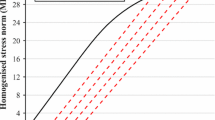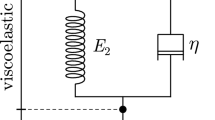Abstract
A new anisotropic elastic-viscoplastic damage constitutive model for bone is proposed using an eccentric elliptical yield criterion and nonlinear isotropic hardening. A micromechanics-based multiscale homogenization scheme proposed by Reisinger et al. is used to obtain the effective elastic properties of lamellar bone. The dissipative process in bone is modeled as viscoplastic deformation coupled to damage. The model is based on an orthotropic ecuntric elliptical criterion in stress space. In order to simplify material identification, an eccentric elliptical isotropic yield surface was defined in strain space, which is transformed to a stress-based criterion by means of the damaged compliance tensor. Viscoplasticity is implemented by means of the continuous Perzyna formulation. Damage is modeled by a scalar function of the accumulated plastic strain \({D(\kappa)}\) , reducing all element s of the stiffness matrix. A polynomial flow rule is proposed in order to capture the rate-dependent post-yield behavior of lamellar bone. A numerical algorithm to perform the back projection on the rate-dependent yield surface has been developed and implemented in the commercial finite element solver Abaqus/Standard as a user subroutine UMAT. A consistent tangent operator has been derived and implemented in order to ensure quadratic convergence. Correct implementation of the algorithm, convergence, and accuracy of the tangent operator was tested by means of strain- and stress-based single element tests. A finite element simulation of nano- indentation in lamellar bone was finally performed in order to show the abilities of the newly developed constitutive model.
Similar content being viewed by others
Explore related subjects
Discover the latest articles and news from researchers in related subjects, suggested using machine learning.References
Bushby AJ, Ferguson VL, Boyde A (2004) Nanoindentation of bone: comparison of specimens tested in liquid and embedded in polymethylmethacrylate. J Mater Res 19: 249–259
Carnelli D, Gastaldi D, Sassi V, Contro R, Ortiz C, Vena P (2010) A finite element model for direction-dependent mechanical response to nanoindentation of cortical bone allowing for anisotropic post-yield behavior of the tissue. J Biomech Eng 132(8): 081008
Carosio A, Willam K, Etse G (2000) On the consistency of viscoplastic formulations. Int J Solids Struct 37(48–50): 7349–7369
Chaboche JL (2008) A review of some plasticity and viscoplasticity constitutive theories. Int J Plast 24: 1642–1693
Charlebois M, Jirasek M, Zysset P (2010) A nonlocal constitutive model for trabecular bone softening in compression. Biomech Model Mechanobiol 9: 597–611
Cowin SC (1979) On the strength anisotropy of bone and wood. J Appl Mech 46(4): 832–838
Cowin S, Mehrabadi M (1995) Anisotropic symmetries of linear elasticity. Appl Mech Rev 48: 247–285
Etse G, Carosio A (1999) Constitutive equations and numerical approaches in rate dependent material formulations, MECOM
Fondrk MT, Bahniuk EH, Davy DT (1999) A damage model for nonlinear tensile behavior of cortical bone. J Biomech Eng 121: 533–541
Fratzl P, Weinkamer R (2007) Nature’s hierarchical materials. Prog Mater Sci 52(8): 1263–1334
Garcia D (2006) Elastic plastic damage laws for cortical bone. Ph.D. thesis, Ecole Polytechnique Federale de Lausanne
Garcia D, Zysset P, Charlebois M, Curnier A (2009) A three-dimensional elastic plastic damage constitutive law for bone tissue. Biomech Model Mechanobiol 8(2): 149–165
Green AE, Naghdi PM (1965) A general theory of an elastic-plastic continuum. Arch Ration Mech Anal 18(4): 251–281
Gross T (2010) The effects of heterogeneous mineralization on the elastic and yield properties of human cancellous bone. Diploma Thesis, Vienna University of Technology
Gupta H, Zioupos P (2008) Fracture of bone tissue: the ’hows’ and the ’whys’. Med Eng Phys 30(10): 1209–1226
Gupta HS, Wagermaier W, Zickler GA, Raz-Ben Aroush D, Funari SS, Roschger P, Wagner HD, Fratzl P (2005) Nanoscale deformation mechanisms in bone. Nano Lett 5(10): 2108–2111
Gupta H, Wagermaier W, Zickler G, Hartmann J, Funari S, Roschger P, Wagner H, Fratzl P (2006) Fibrillar level fracture in bone beyond the yield point. Int J Fract 139: 425–436
Gupta HS, Fratzl P, Kerschnitzki M, Benecke G, Wagermaier W, Kirchner HO (2007) Evidence for an elementary process in bone plasticity with an activation enthalpy of 1 eV. J R Soc Interface 4(13): 277–282
Hansma P, Fantner G, Kindt J, Thurner P, Schitter G, Turner P, Udwin S, Finch M (2005) Sacrificial bonds in the interfibrillar matrix of bone. J Musculoskelet Neuronal Interact 5(4): 313–315
Hellmich C, Ulm FJ (2002) Are mineralized tissues open crystal foams reinforced by crosslinked collagen?—some energy arguments. J Biomech 35(9): 1199–1212
Hengsberger S, Kulik A, Zysset P (2002) Nanoindentation discriminates the elastic properties of individual human bone lamellae under dry and physiological conditions. Bone 30(1): 178–184
Keyak JH, Rossi SA (2000) Prediction of femoral fracture load using finite element models: an examination of stress- and strain-based failure theories. J Biomech 33(2): 209–214
Kuhn HW, Tucker AW (1951) Nonlinear programming. In: Proceedings of 2nd Berkeley symposium. University of California Press, pp 481–492
Lucchini R, Carnelli D, Ponzoni M, Bertarelli E, Gastaldi D, Vena P (2011) Role of damage mechanics in nanoindentation of lamellar bone at multiple sizes: experiments and numerical modeling. J Mech Behav Biomed Mater 4(8): 1852–1863
Maghous S, Dormieux L, Barthèlèmy J (2009) Micromechanical approach to the strength properties of frictional geomaterials. Eur J Mech A Solids 28(1): 179–188
Mazza G (2008) Anisotropic elastic properties of vertebral bone measured by microindentation. Diploma thesis, Politecnico di Milano
Natali A, Carniel E, Pavan P (2008) Constitutive modelling of inelastic behaviour of cortical bone. Med Eng Phys 30(7): 905–912
Nemat-Nassar S, Mori M (1993) Micromechanics: overall properties of heterogeneous materials. Elsevier Science Publishers, The Netherlands
Perzyna P. (1966) Fundamental problems in viscoplasticity. Elsevier, The Netherlands, pp 243–377
Ponthot JP (1995) Radial return extensions for visco-plasticity and lubricated friction. In: SMIRT-13 international conference on structural mechanics and reactor technology
Poon B, Rittel D, Ravichandran G (2008) An analysis of nanoindentation in linearly elastic solids. Int J Solids Struct 45(24): 6018–6033
Rakatomanana RL, Curnier A, Leyvraz PF (1991) An objective elastic plastic model and algorithm applicable to bone mechanics. Eur J Mech A Solids 10(3): 327–342
Reisinger A, Pahr D, Zysset P (2010) Sensitivity analysis and parametric study of elastic properties of an unidirectional mineralized bone fibril-array using mean field methods. Biomech Model Mechanobiol 9: 499–510
Reisinger A, Pahr D, Zysset P (2011) Elastic anisotropy of bone lamellae as a function of fibril orientation pattern. Biomech Model Mechanobiol 10: 67–77
Shih CF, Lee D (1978) Further developments in anisotropic plasticity. J Eng Mater Technol 100(3): 294–302
Simo JC, Ju JW (1987) Strain- and stress-based continuum damage models—I. Formulation. Int J Solids Struct 23(7): 821–840
Spiesz EM (2011) Experimental and computational micromechanics of mineralized tendon and bone. Ph.D. thesis, Vienna University of Technology
Spiesz EM, Reisinger AG, Roschger P, Zysset PK (2011) Experimental validation of a multiscale model of mineralized collagen fibers at two levels of hierarchy. Osteoporos Int 22: 561–666
Sugawara Y, Kamioka H, Honjo T, Tezuka K, Takano-Yamamoto T (2005) Three-dimensional reconstruction of chick calvarial osteocytes and their cell processes using confocal microscopy. Bone 36(5): 877–883
Tai K, Ulm FJ, Ortiz C (2006) Nanogranular origins of the strength of bone. Nano Lett 6(11): 2520–2525
Voyiadjis G, Peters R (2010) Size effects in nanoindentation: an experimental and analytical study. Acta Mech 211: 131–153
Weiner S, Arad T, Sabanay I, Traub W (1997) Rotated plywood structure of primary lamellar bone in the rat: orientations of the collagen fibril arrays. Bone 20(6): 509–514
Weiner S, Wagner HD (1998) The material bone: structure-mechanical function relations. Annu Rev Mater Sci 28(1): 271–298
Weiner S, Traub W, Wagner H (1999) Lamellar bone: structure-function relations. J Struct Biol 126(3): 241–255
Wolfram U, Wilke HJ, Zysset PK (2010) Rehydration of vertebral trabecular bone: influences on its anisotropy, its stiffness and the indentation work with a view to age, gender and vertebral level. Bone 46(2): 348–354
Yeni Y, Dong X, Fyhrie D, Les C (2004) The dependence between the strength and stiffness of cancellous and cortical bone tissue for tension and compression: extension of a unifying principle. Bio-Med Mater Eng 14(3): 303–310
Zhang J, Niebur GL, Ovaert TC (2008) Mechanical property determination of bone through nano- and micro-indentation testing and finite element simulation. J Biomech 41(2): 267–275
Zhang J, Michalenko MM, Kuhl E, Ovaert TC (2010) Characterization of indentation response and stiffness reduction of bone using a continuum damage model. J Mech Behav Biomed Mater 3(2): 189–202
Zinkiewicz OC, Valliapan S, King IP (1969) Elastoplastic solutions of engineering problems initial stress, finite element approach. Int J Num Methods Eng 1: 75–100
Zysset PK (1994) A constitutive law for trabecular bone. Ph.D. thesis, Ecole Polytechnique Federale de Lausanne
Zysset PK, Curnier A (1995) An alternative model for anisotropic elasticity based on fabric tensors. Mech Mater 21(4): 243–250
Zysset PK, Guo EX, Hoffler EC, Moore KE, Goldstein SA (1999) Elastic modulus and hardness of cortical and trabecular bone lamellae measured by nanoindentation in the human femur. J Biomech 32(10): 1005–1012
Author information
Authors and Affiliations
Corresponding author
Rights and permissions
About this article
Cite this article
Schwiedrzik, J.J., Zysset, P.K. An anisotropic elastic-viscoplastic damage model for bone tissue. Biomech Model Mechanobiol 12, 201–213 (2013). https://doi.org/10.1007/s10237-012-0392-9
Received:
Accepted:
Published:
Issue Date:
DOI: https://doi.org/10.1007/s10237-012-0392-9




